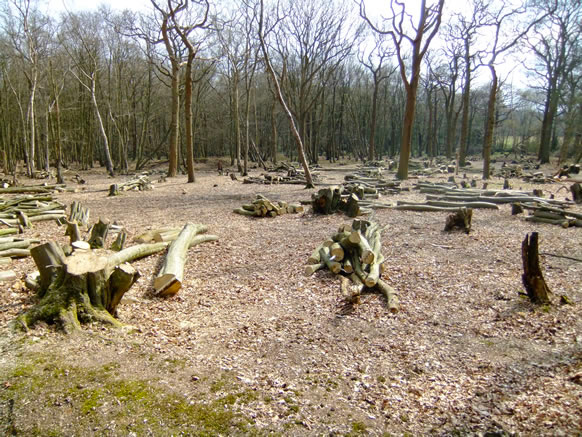About Ruislip Woods
Brief History
Ruislip Woods National Nature Reserve is ‘ancient semi natural woodland’ and some parts are a remnant of the Wildwood that once completely covered England after the last ice age, about 8,000 years ago. The woodland is still predominantly hornbeam (Carpinus Betulus) coppice with oak standards and is interesting because of the occurrence of both pedunculate oak (Quercus Robur) and sessile oak (Quercus Petraea). The mixture of hornbeam and beech (Fagus Sylvatica) in Bayhurst Wood is also unusual and wild service trees (Sorbus Torminalis) can be found throughout the woodland.
When the land was first cleared for agriculture some woodland was left to provide timber and firewood. Coppicing of hornbeams, to generate timber and firewood is known to have occurred for over five centuries up to the 1930’s but it steadily reduced thereafter, ceased by the 1950’s and restarted in 1982. For more information on coppicing as a way to manage the woodland see the section on Management of Ruislip Woods here.
The Woods are now actively managed for conservation and recreational purposes and in 1997 was awarded the status of National Nature Reserve (NNR)- see below for more information.
Ruislip Woods Today
Ruislip Woods consists of Bayhurst Wood, Copse Wood, Mad Bess Wood, Park Wood, Poor’s Field/Ruislip Common, the Ruislip Local Nature Reserve, The Northern Finger, Grub Ground, Tarleton’s Lake and surrounding land in Hillingdon. Ruislip Woods National Nature Reserve (NNR), at 305 hectares or 755 acres, is the biggest single area of woodland in Greater London. Park Wood is one of the largest ancient woods in England in a completely semi-natural state. Bayhurst Woods lies within the Colne Valley Regional Park.
As the public awareness and profile of the Woods increase and it becomes a more interesting place to visit, the habitats are put under increasing pressure. Over the years, on top of increasing numbers of recreational users, there has been an increase in visits for educational purposes, both formal (schools and colleges), and informal (self-education and interest groups).
To prevent this pressure from damaging the habitats, there is a need to provide guides, maps of interesting walks, and waymarking, which also enhances the visitors’ experience. The NNR designation magnifies the necessity for these matters to be addressed.




Nature Conservation
Ruislip Woods has a great importance for nature conservation partly because of the unbroken historical link with the Wildwood but also because of their size.
Some years ago on a half-day visit to Ruislip Woods experts attending a European Mycology Congress at Kew identified 585 species of fungus including four that had never been recorded previously in Britain. Ruislip Woods is the richest site in Greater London for lichens on trees. A bat survey carried out by volunteers over two years showed that Ruislip Woods could well be the richest site in the region for these mammals about which surprisingly little is known. We continue to run Bat walks, details of which are published under Events.
Picking Fungi in Ruislip Woods is forbidden because of the National Nature Reserve Status (see more information below).

National Nature Reserve Status
Since 1982 Ruislip Woods have been actively managed. The purpose of this active management is to foster a greater diversity and richness of species and habitats and to maintain those habitats that make this area so interesting biologically. English Nature have studied the improvement in the variety and quality of those habitats and awarded Ruislip Woods the status of a National Nature Reserve (NNR) on 21st May 1997. Ruislip Woods was the first NNR in an urban area in England.
The video opposite shows the declaration of London’s First National Nature Reserve by Lord Cranbrook of English Nature and the longhorn cattle being released for grazing at Ruislip Common for the first time (for 50+years).
As the number of people using Ruislip Woods increases, to prevent this pressure from damaging the habitats, there is a need to provide guides, maps of interesting walks, and waymarking, which also enhances the visitors’ experience. The NNR designation magnifies the necessity for these matters to be addressed. Many of these matters are actioned by the Ruislip Woods Trust.


Changing Landscapes
The Friends of Colne Valley Park have a wonderful photo album dating from 1982. Someone took a photo at each grid reference in the whole of the 43 square miles of the Colne Valley looking north, south, east and west at each point. The photos seen here are looking north, the black and white photo from 1982 and the colour photo from 2014.
The Friends of Colne Valley Park won a Lottery Heritage grant to repeat these photos and provide an illustration of the changes to our landscape. In the process they hope to involve many local residents and exchange knowledge of the local areas and to pass on skills including photography, map reading and conservation.
One of these grid points is in Bayhurst Woods and the photos from 1982 are reproduced opposite. If you would like to take your own photo to see the difference now the grid reference is 890 070
To see the original photos taken in 1982 at this position compared against photos taken more recently in the same position click on this link- Landscape Camera Bayhurst Woods
If you do go out and reproduce the scene it would be wonderful if you could share the photos with us and maybe allow us to print them in a future edition of our newsletter.
If you would like to share with us any photos that you have taken in Ruislip Woods, you can either tag us on Twitter; @RuislipWoods or email using the details here: Contact Us
Click here for further details of the Landscape Camera Project
Filming Requests
Ruislip Woods is a popular location for filming.
If you would like to undertake filming or photoshoots on site please email the Film Office at Hillingdon Council to check if you require a permit: filmoffice@hillingdon.gov.uk

Page last updated: 18/06/2023
By Anand Punja
